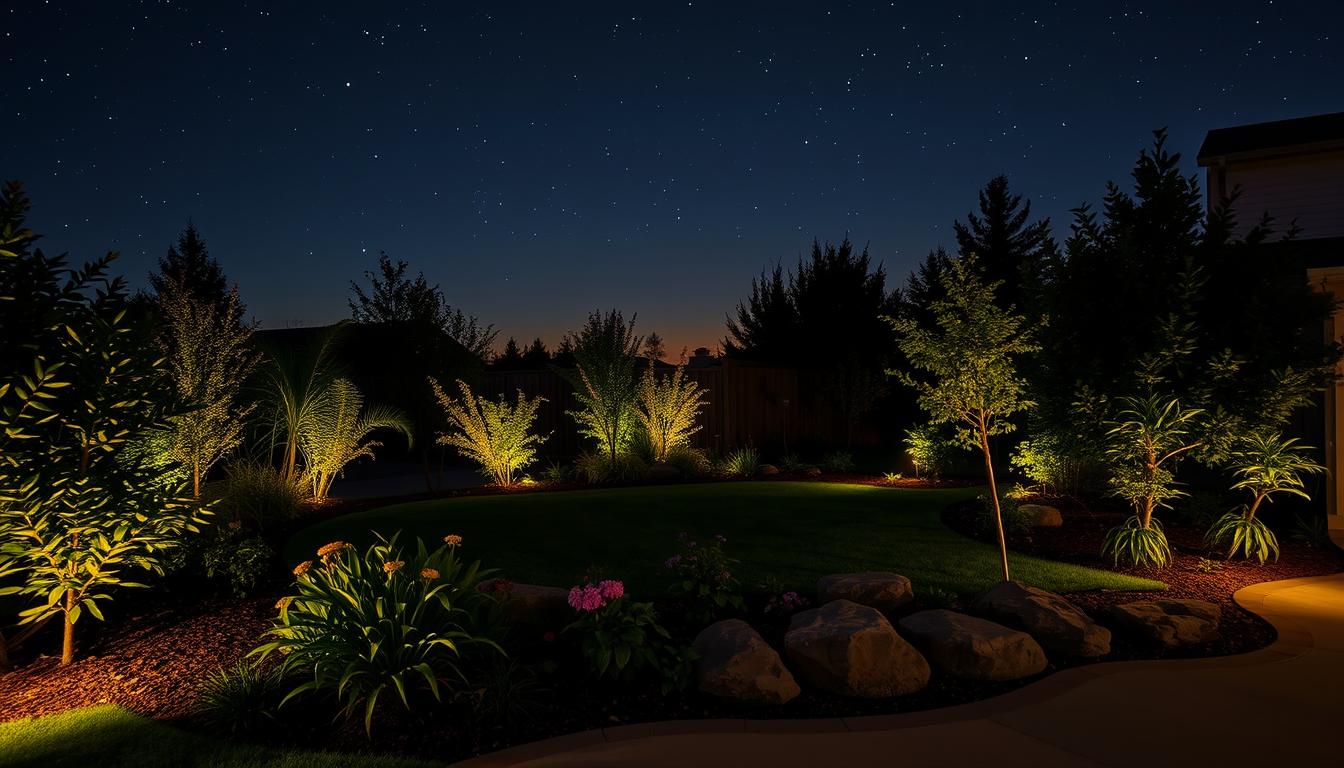Outdoor lighting can make your garden and outdoor space look better and safer. A good low-voltage landscape lighting system can make your home welcoming. We’ll show you how to set up the perfect outdoor lighting for your garden.
Looking to make your home safer or more inviting? Low-voltage landscape lighting is a great choice. Our guide will help you start your outdoor lighting project. We’ll cover planning, design, installation, and keeping your lights in good shape.
Key Takeaways
- Low-voltage landscape lighting is safe and saves energy for your outdoor space.
- A good outdoor lighting system can make your home and garden look better and safer.
- Installing and maintaining your system right is key to its lasting performance.
- Outdoor lighting can highlight your garden’s best parts, like paths and gardens.
- Our guide will walk you through planning, designing, and installing your system step by step.
- Follow our guide to create a beautiful and useful outdoor lighting setup for your garden.
- Low-voltage landscape lighting can also increase your home’s value and appeal.
Understanding Low-Voltage Landscape Lighting Basics
Low-voltage landscape lighting is a favorite among homeowners. It’s safe, energy-saving, and easy to set up. Low voltage systems run at a lower voltage than regular lights. This makes them great for outdoor use. Let’s explore what makes low-voltage lighting so popular.
Low-voltage systems are safer because they have lower voltage. This means less chance of getting shocked. They also use less energy, saving you money. Plus, they’re simple to install, even for DIY enthusiasts.
What is Low-Voltage Lighting?
Low-voltage lighting is for outdoor spaces. It runs at 30 volts or less. It’s perfect for lighting up gardens, paths, and patios.
Benefits of Low-Voltage Systems
Low-voltage systems offer many advantages:
- Safety: less chance of getting shocked
- Energy efficiency: saves energy and money
- Ease of installation: simple to set up
Components Overview
A low-voltage system has a transformer, cable, and fixtures. The transformer lowers the voltage to a safe level. The cable connects the transformer to the fixtures, which work at low voltage.
Knowing the basics of low-voltage lighting helps homeowners choose the right system. It makes their outdoor spaces look better and feel safer.
| Component | Description |
|---|---|
| Transformer | Steps down voltage from household supply |
| Cable | Connects transformer to fixtures |
| Fixtures | Designed to operate at low voltage levels |
Safety Considerations Before Installation
When dealing with low-voltage landscape lighting, safety is key. Before you start, think about safety to avoid accidents and follow local electrical codes. It’s important to focus on proper wire routing to prevent electrical shocks and fires. This means planning your wire layout carefully to avoid hazards.
To install safely, turn off the power first and wear protective gear. This includes insulated gloves, safety glasses, and a non-contact voltage tester. These steps help reduce the risk of electrical shock and ensure a good installation.
- Using weather-resistant connectors and cables to prevent water damage
- Avoiding overloading circuits to prevent electrical fires
- Keeping wires away from heat sources and flammable materials
By following these safety tips and focusing on proper wire routing, you can have a safe and successful installation of your low-voltage landscape lighting.
Essential Tools and Materials Needed
For a successful transformer installation, the right tools and materials are key. You’ll need cables, fixtures, and digging tools. A well-planned installation boosts your landscape lighting’s efficiency and safety.
Start by making a detailed list of tools and materials needed. You’ll need a wire stripper, pliers, and a shovel for digging. Also, choose the right transformer size for your landscape and number of fixtures.
Required Tools Checklist
- Wire stripper
- Pliers
- Shovel
- Transformer
- Cables
- Fixtures
Materials Shopping List
When buying materials, focus on quality and durability. Choose reputable brands for outdoor use. Halogen and LED fixtures are great for their energy savings and long life.
Optional Equipment Recommendations
Consider adding timers and smart controls for extra customization. These can make your lighting system more efficient. With the right tools and materials, you’re set for a successful installation and a beautifully lit landscape.
| Tool/Material | Description | Recommended Brand |
|---|---|---|
| Transformer | Essential for powering your landscape lighting system | Hampton Bay |
| Cables | Used to connect fixtures to the transformer | Southwire |
| Fixtures | Available in a variety of styles and designs | Malibu |
Planning Your Landscape Lighting Design
Creating a beautiful outdoor space is all about lighting design. It’s key to think about your yard’s features, the mood you want, and where to put the lights. Start by walking around your yard and marking the spots you want to highlight, like gardens or walkways.
A good lighting design can really change how your outdoor area looks and feels. Here are some important things to think about:
- Look at how much natural light your yard gets and how it will affect your lighting design
- Pick the right kind of lighting, like uplighting, downlighting, or pathway lights
- Think about the color and brightness of the lights to set the mood you want
Planning your lighting design carefully can make your outdoor space both beautiful and useful. Think about your yard’s special features and pick lights that go well with them. With some planning and creativity, you can make a great outdoor area for relaxing and having fun.
| Area | Lighting Type | Intensity |
|---|---|---|
| Walkway | Pathway lighting | Low |
| Garden | Uplighting | Medium |
| Patio | Downlighting | High |
Choosing the Right Transformer Location
The location of your transformer is key to a great outdoor ambiance. It should be close to a power source, protected from the weather, and easy to get to for maintenance. A good transformer spot can make your landscape lighting look better, while a bad one can ruin it.
For a safe and efficient low-voltage landscape lighting system, think about these when picking a transformer spot:
- Proximity to a power source: The transformer should be near a power source to avoid voltage drop and ensure efficient energy transfer.
- Weather protection: The transformer needs to be safe from rain, snow, and extreme temperatures to prevent damage and keep it working well.
- Accessibility: The transformer should be easy to get to for maintenance and repairs to avoid long downtime and keep the system running smoothly.
By carefully choosing a transformer spot, you can make your outdoor space both beautiful and useful. A well-designed landscape lighting system can make your outdoor area look great while also keeping it safe and secure.
Remember, the secret to a welcoming outdoor space is finding the right balance between looks and function. By picking the best spot for your transformer, you ensure your landscape lighting works well and adds to your outdoor area’s beauty.
Cable Selection and Layout Strategy
When setting up garden lights, picking the right cable and planning its path are key. The cable for low voltage systems must be weather-resistant. It should handle different weather conditions well.
To figure out cable length, measure from the transformer to each garden light. Remember to add 10-15% for any unexpected issues. This helps avoid problems.
Here are some tips for laying out the cables:
- Choose a cable with a tough outer jacket to protect it
- Avoid areas with lots of foot traffic or where it could get damaged
- Secure cables with ties or clips to trees, fences, or other stable objects
By using these tips and the right materials, you can make a beautiful low voltage system. This will make your outdoor space look great. Always follow safety rules and get help from a pro if needed.
With a good cable layout and the right materials, your garden lights will last for years. They will add beauty and ambiance to your outdoor area.
| Cable Type | Recommended Use |
|---|---|
| 18-gauge cable | Short distances, less than 50 feet |
| 16-gauge cable | Medium distances, 50-100 feet |
| 14-gauge cable | Long distances, over 100 feet |
Installing Your Transformer and Power Supply
For outdoor lighting, a well-installed transformer and power supply are key. Start by following the manufacturer’s guide for mounting the transformer. Make sure it’s securely fastened and protected from the weather.
Next, make the electrical connections carefully. This step is crucial to avoid hazards. Proper wire routing is important here. It prevents cable damage and ensures a reliable connection.
Mounting and Connection Procedures
- Mount the transformer in a spot that’s easy to reach and weather-proof.
- Follow the manufacturer’s guide for electrical connections. Ensure all wires are securely attached and safely routed.
- Test the system to make sure it’s working right and adjust as needed.
By following these steps, you can have a safe and efficient outdoor lighting system. It will make your landscape look even better.
Testing and Verification
After installation, test the system to make sure it’s working as it should. Check that all lights are on and the transformer and power supply are within the right limits.
| Component | Verification Steps |
|---|---|
| Transformer | Check for proper mounting and electrical connections |
| Power Supply | Verify output voltage and current ratings |
| Outdoor Lighting Fixtures | Test each fixture to ensure proper operation |
Proper Wire Routing Techniques
Proper wire routing is key in transformer installation to avoid cable damage and ensure efficiency. A good lighting design should consider wire placement to reduce voltage drop. This section will cover trenching, cable connections, and voltage drop minimization.
First, plan the wire routing carefully. Think about the landscape layout and transformer location. This helps avoid cable damage and ensures correct installation. Important points include:
- Trenching methods: Digging trenches to protect cables from damage and keep them hidden.
- Connection points: Connecting cables to fixtures and the transformer correctly is vital to prevent voltage drop and ensure efficiency.
- Voltage drop considerations: Calculating voltage drop is necessary to ensure the system works well and cables are not overloaded.
By using these techniques and considering key factors, your transformer installation will be done right. Your lighting design will be efficient and effective.
Fixture Placement and Installation
Installing garden lights is key to a great outdoor look. Where you put the lights and how they shine matters a lot. The light’s angle, spread, and how it changes the landscape are all important.
To get the perfect outdoor feel, think about these things:
- Light direction: Make sure the light shines where you want it, like on a path or a garden spot.
- Beam spread: Pick a spread that fits the area, like a narrow beam for a special feature or a wide beam for a bigger area.
- Fixture type: Choose a light that’s right for the spot, like a recessed light for paths or a pendant light for patios.
Installing lights right is also key. It keeps them safe and working well. This means making sure they’re fixed tight so weather or people can’t knock them over.
By picking the right spot and installing lights well, you can make your outdoor space beautiful and welcoming. It will make your landscape look even better.
| Fixture Type | Beam Spread | Light Direction |
|---|---|---|
| Pathway Light | Narrow | Downward |
| Pendant Light | Wide | Downward |
| Spotlight | Narrow | Adjustable |
Programming and Timer Setup
Low voltage systems are great for outdoor lighting because they save energy. To make the most of your system, setting up programming and timers is key. This lets you control when your lights come on and off, adapting to the seasons.
For simple timers, you can set lights to turn on at dusk and off at dawn. Or, you can tailor the schedule to your liking. Many systems also have smart features like Wi-Fi control and dusk-to-dawn sensors. These let you change your lighting from your phone or tablet.
Basic Timer Functions
- Set schedule for lights to turn on and off
- Adjust for seasonal changes
- Customize lighting zones for different areas of your yard
Smart Control Options
Smart control takes your outdoor lighting to the next level. These systems often include:
- Remote control through Wi-Fi connectivity
- Dusk-to-dawn sensors for automatic adjustment
- Energy monitoring to track your usage
Seasonal Adjustments
As seasons change, so do your lighting needs. With timers and smart controls, adjusting your lighting is easy. This way, you can keep up with daylight hours and your outdoor plans.
Troubleshooting Common Issues
Low-voltage landscape lighting can sometimes have problems, even with careful planning and transformer installation. Issues like flickering lights, non-working fixtures, and tripped circuit breakers can happen. To fix these, it’s important to follow a step-by-step troubleshooting guide.
Start by checking the wire routing and making sure all connections are tight. Loose wires can lead to voltage drops and overheating. Also, make sure the transformer fits the lighting system and the wire routing is correct to avoid voltage loss.
Some common troubleshooting steps include:
- Checking for loose connections and tightening them as needed
- Verifying that the transformer is properly sized for the lighting system
- Ensuring that the wire routing is done correctly to minimize voltage drop
By following these steps and being methodical, you can quickly find and fix common problems with your low-voltage landscape lighting. This ensures it works right and adds beauty and safety to your outdoor area.
Conclusion: Enjoying Your Illuminated Outdoor Space
Congratulations! You’ve turned your outdoor area into a beautiful space with a low-voltage lighting system. The outdoor ambiance and garden lights make your property look great. They also make it warm and welcoming for everyone.
Now, take a moment to enjoy what you’ve done. Try out different lighting settings to find what you like best. Also, remember to keep your lights clean and check connections to keep them working well.
With your new lighting, you’ll have many nights to enjoy outside. Relax and have fun in the soft light of your beautifully set up space. Enjoy the outdoor ambiance and the beauty of your lit-up area.


